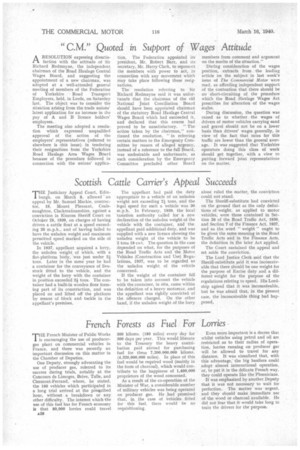Scottish Cattle Carrier's Appeal Succeeds
Page 30

If you've noticed an error in this article please click here to report it so we can fix it.
-rHE Justiciary Appeal Court, Edin
burgh,on March 8, allowed an appeal by Mr. Samuel Mackie, contractor, 19, Mount Pleasant, Coalsnaughton, Clackmaimanshire, against a conviction in Kinross Sheriff Court on October 25, 1939, on charges of having driven a cattle float at a speed exceeding 20 m.p.h., and of having failed to have the unladen weight and maximum permitted speed marked on the side of the vehicle.
In 1937, appellant acquired a lorry, the unladen weight of which, with a flat-platform body, was just under 21 tons. Later in the same year he had a container for the conveyance of livestock fitted to the vehicle, and the weight of the lorry with the container in position exceeded 2i tons. The container had a built-in wooden floor forming part of its construction, and was placed on and lifted off the platform by means of block and tackle in the appellant's premises. The appellant had paid the duty appropriate to a vehicle of an'unladen weight not exceeding 2i tons, and the legal speed for such a vehicle was 30 m.p.h. In February, 1939, the local taxation authority called for a new declaration of the unladen weight of the vehicle with the container, and the appellant paid additional duty, and was supplied with a new licence showing the unladen weight of the vehicle to be 2 tons 19 cwt. The question in the case depended on what, for the purposes of the Road Traffic Acts and the Motor Vehicles (Construction and Use) Regulations, 1937, was to be regarded as the unladen weight of the vehicle concerned.
If the weight of the container fell to be taken into account the vehicle with the container, in situ, came within the definition of a heavy motorcar, and the appellant was rightly convicted of the offences charged. On the other hand, if the unladen weight of the lorry alone ruled the matter, the conviction could not stand.
The Sheriff-substitute had convicted on the ground that as the only definitions of weight, as applied to motor vehicles, were those contained in Section 26 of the Road Traffic Act, 1930, and Section 7 of the Finance Act, 1937, and as the word " weight " ought to be given the same meaning in the Road Traffic Acts and in the Finance Acts, the definition in the later Act applied.
The Court sustained the appeal and set aside the conviction.
The Lord Justice Clerk said that the Sheriff-substitute said it was inconceivable that there should be one weight for the purpose of Excise duty and a different weight for the purpose of the regulations relating to speed. His Lordship agreed that it was inconceivable, but he was afraid that, in the present case, the inconceivable thing had happened.




































































